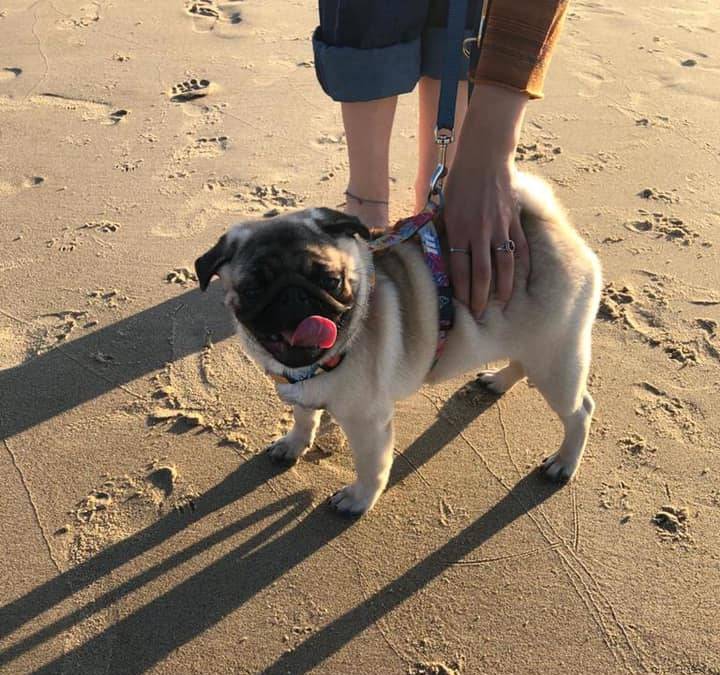PUGS
ABOUT THE BREED
In the history of the pug, one can find various hypotheses of the origin of its ancestors. The most trustworthy theory is the one about the arrival of the pug from China via the Silk Road. This breed may have even been created for thousands of years within the Chinese Court.
Until the 19th century, mops could only be owned by members of the imperial Chinese court. There was even a death penalty for breeding outside the palace walls. These dogs remained a mystery to both the world and the Chinese themselves for hundreds of years.
The situation was changed by the British-Chinese War, through which the British came into possession of Chinese small companion dogs.
APPEARANCE
Pugs belong to the brachycephalic group of dogs (with a short muzzle and flattened muzzle). They are very contactable, sociable, trusting, intelligent and very fast learners. The breed is also characterized by great stubbornness. The easiest way to motivate a pug to follow commands is with a reward in the form of a treat. It is a very patient and gentle breed, perfectly suited for families with children and very badly tolerates prolonged solitude.
These are small, stocky and muscular dogs belonging to the molosser group. Although dogs of this breed in adulthood sleep a good part of the day, snoring deliciously, and are reluctant to leave the house in bad weather, they like to go out, run after a ball and play with a tug. When young, they are extremely energetic dogs.

The pug is a breed that has undercoat in addition to its coat, and the period of moulting occurs almost all year round and is quite troublesome. Proper grooming, supplementation and diet greatly reduce the problem of moulting. However, this is not a breed for people who are oversensitive about it.
Contrary to various rumors, pugs do not have their eyes fall out. This can happen only during a serious injury, accident or attack by another dog, however, it should be remembered that this applies to all breeds, not just pugs.
PHYSICS
Some people believe that pugs have a tendency to get fat. And in fact, we caregivers tend to have bad habits. We often overfeed pugs, who do not complain about lack of appetite, and we do not devote enough time to physical activity, thinking that short walks are enough.
Another important thing is the pug's build, which should be strong and athletic. A well-built and well-groomed pug will be a massive and muscular dog. However, one should be able to distinguish between a muscular physique and an overweight one. A properly fed pug will be muscular, not fat.
INFO
When buying a pug from a good kennel, we must realize that the breed is specific, very beloved, and if someone has had a pug in the family once, he will certainly return to this breed.
However, we should familiarize ourselves with all the diseases of the breed before we decide to own a pug.
The most common condition of this breed is PDE - pug encephalitis. It is a genetic disease and virtually incurable. Typical symptoms are any neurological abnormalities, epilepsy, seizures, vision loss, imbalance. Diagnosis is based on MRI and genetic testing. The genetic test determines the degree of risk of the disease, but does not provide a full guarantee.
NN result - it is a low-risk individual
NS - carrier individual (low risk of disease) and
SS - a high-risk individual (with a 12-fold higher risk of disease than an NN or NS individual).
We need to know that NN and NS pugs have a very marginal chance of getting sick and should not cause us any concern.
We also need to know what a retrograde cough (retrograde sneezing) is. During a coughing fit, the pug tenses up and sucks air inside. Such a coughing fit lasts from a few seconds to a few minutes, and occasionally occurring does not require a visit to the vet. Although it is harmless, observing this reflex can be surprising and unpleasant for both dog and owner.
ADDITIONALLY
Trzeba pamiętać, że nie istnieje rasa, która nie ma obciążeń genetycznych. Mops ma swoje przypadłości zdrowotne, dlatego trzeba kupować mopsa świadomie, z dobrej hodowli , gdzie rodzice posiadają komplety badań. Takie badania dają większą szansę właścicielom na nabycie zdrowego psa, który będzie cieszył się dobrym samopoczuciem. Należy jednak pamiętać, że kupujemy żywe stworzenie, a nie przedmiot na który dostajemy gwarancję na długie lata. A kupując szczeniaka z profesjonalnej hodowli możemy liczyć na pomoc ze strony hodowcy, dostęp do jego wiedzy i doświadczenia, co może okazać się bezcenne.
